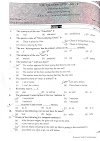- Introduction
is the tendency of restoring / recovering the original shape and size of deformed body after the deforming force is removed. regains its original shape and size completely after removal of deforming force. Eg: Quartz fiber, Phosphor bronze etc. does not regain its original shape and size at all. Eg: mud, wax, plastics etc.
Restoring force applied in a unit areaStress is a tensor quantity with dimension and unit .
Normal stress: Normal force per unit cross-section area.Tangential or Shearing stress:Tangential force applied parallel to surface per unit area of that surface producing shearing (change in shape).Volume stress: Force per unit total surface area producing change in volume.
The change in dimension of body per unit original dimension is strain.Strain = Strain is unit less and dimension less physical quantity.
Change in length per unit initial length. Strain (long.) Change in volume per unit original volume and is given by Change in position per unit original position. It is generally represented by angle θ through which a body initially fixed is twisted under the action of tangential deforming force. Shearing force
Hooke's law
It states that, "Within elastic limit, extension produced is directly proportional to force applied."i.e. F = -k.e ; where k is force constant.
It also states, within elastic limit, stress is directly proportional to the straini.e. so, (modulus of elasticity)
It is the ratio of normal stress to the longitudinal strain, within the elastic limit.
It is property of solid body only.Young's modulus of elasticity increases on mixing the impurity in the solid and decreases on increasing temperature of solid body.
Ratio of normal stress to volumetric strain within elastic limit.( -ve sign indicates decreasing of volume on increasing of applied force)
Bulk modulus is property of solid, liquid and gases.Gases have isothermal and adiabatic bulk modulus of elasticity.K is minimum for gases (maximum volume change) and maximum for solid (minimum volume change)Reciprocal of bulk modulus of elasticity is Compressibility.
Ratio of tangential stress to shearing strain within elastic limit.
It is property of solid materials only. And its value is zero for liquid.The ratio of lateral strain to longitudinal strain
(-ve sign indicates decrease of radius in expense of increasing length for constant volume) Theoretical value of σ lies in between -1 to but practical lies between 0 to Fractional change in volume : ( so, change in volume is zero when the value of σ 0.5 )
Energy stored during elastic deformation
A step towards visualization
Think of a triangle with extension (x) as its base and the force applied on body to produce that extension be represented by height of triangle. Where, force And is the force constant of that elastic body. Then, area of that triangle represents the work done in stretching the body by .
So, elastic potential energy stored
Elastic P.E in a stretched wire(U)
Energy density / elastic energy per unit volume
Extension of rope by its own weight
- For small element
, the small extension produced on the rope above the element will be:
[ where, is mass of element and is length of rope ]so, now, for total extension on the rope due to its own weight, we have to integrate from bottom to top of rope
FEEL THE POINTS
Y for elastic body is infinity.
Y for perfectly plastic body is zero.
Young's modulus (Y) measures extensibility, bulk modulus (B) measures compressibility while shear modulus (η) measures rigidity.
On increasing temperature Y, β, η all decrease on account of decrease in intermolecular force.
Thermal force set up due to thermal expansion = F = Y θαA
Breaking stress depends upon material only while breaking strength depends on material and cross-section area but independent of length.Breaking stress Y and Breaking Strength A
The area under the stress – strain graph represents the work done per unit volume.









0 Comments